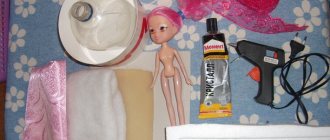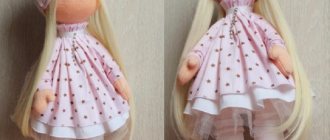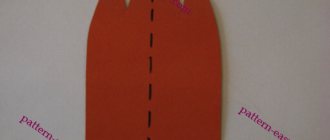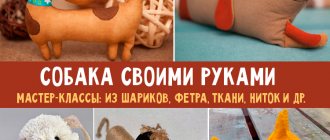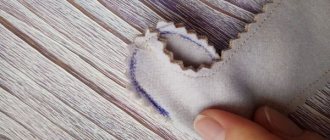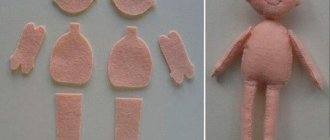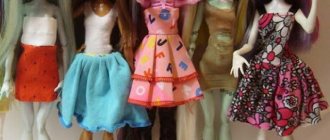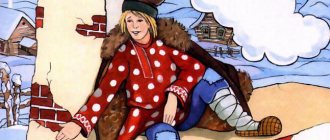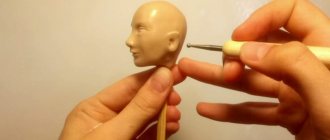In ancient times, the Slavs had a tradition of making amulets from fabric. Every family made a lot of them for all occasions. One of the most popular was the herbalist doll. It was not only a talisman protecting against misfortunes and evil spirits. It also contained elements of healing. Medicinal herbs that filled the pupa prevented illness, improved sleep, and drove away infections. And it’s not difficult to make such a talisman, you just need to choose the right materials and follow traditions.
The history of the amulet
In ancient times, the Slavs had dolls-amulets in every home. They protected the house from evil people and evil spirits, and served as personal talismans. Each had its own meaning. The herbalist was also called the Kubishka, since its filling was also sacred. If magical herbs were used to ward off evil forces, such a doll would purify the air in the house, ward off illnesses and misfortunes, and create a favorable atmosphere.
But most often the herbalist was filled with fragrant medicinal herbs. Such a doll was placed at the head of the bed and given to children to play with. When crushed, it gave off a pleasant aroma. It protected a person from infections, calmed or invigorated, and helped to stay healthy. These amulets were made from scraps of clothing. In the 20th century, rag dolls almost disappeared; people stopped believing in their power. But the tradition of making it has remained; some people still protect their home and family members with the help of such amulets.
The herbal pot is the most popular Slavic amulet.
LiveInternetLiveInternet
Quote from message Makosh311
Read in full In your quotation book or community!
It's time to collect herbs for treatment, for spells, for fulfilling wishes and protecting the hearth. While the herbs are fragrant, while they are juicy, create amulets and medicinal supplies.
The most significant and effective amulet and remedy for many peoples of the earth are dolls made from herbs.
In ancient times, dolls made of grass and straw served our ancestors as protectors from evil forces and guardians of the hearth. Nowadays, many folk recipes and secrets for making such dolls have been forgotten. However, nothing disappears into nowhere, nor is it taken out of nowhere.
And forgotten recipes come from the past, and new ones come into the light.
The most common and easiest to make is the “motanka doll” .
Motanka dolls are made from flowers, steppe and forest medicinal herbs. But the secret is not in what grass the amulet is “born” from, but in what mood it is made. It takes several hours or days to make a doll, and all this time the creator of the amulet must be focused on the positive “message” that is conveyed to his work. There are also certain canons: a grass figurine made of cattails, depicting the goddess Lada, certainly raises its “hands” to the sun. The Slavs gave young couples dolls with crossed arms, and these two figures were sewn or fastened with a herbal “thread”, symbolizing inextricable unity.
Also, amulets should not have a “face”. It is believed that if a motanka doll reproduces the facial features of a particular person, then it can become the object of a hex-spell aimed at causing harm to that person. By the way, not all herbal or straw amulets of the ancient Slavs had “human” shapes. Sometimes the doll can simply be twisted into a spiral with the ends tied together with grass.
Dry a few flowers and weave them into a doll (or just stick them in) - and the doll takes on a magical meaning: - forget-me-not - so that a dear person is never forgotten; - chamomile - for clear days and health, - immortelle - for long summers; - St. John's wort - to combat all diseases; - tansy - to keep the house clean; - spikelets of bread - for productivity on the farm and full of grain. From time immemorial, grass dolls have been amulets and protectors against diseases for children.
The most common children's play doll is the “haircut” . It was made from cut grass. When the woman went to the field, she took the child and, so that he could play with something, made him a doll out of grass. Often such a doll was used for medicinal purposes. When a child was sick, medicinal herbs were woven into such a doll. And when the child played with it, the smell of the grass had a healing effect on him.
Grass dolls were used in many rituals for both good and evil.
They made dolls from herbs, tying them with threads or the same grass. They placed it inside depending on opportunity and need. For the enemy, a chicken heart and giblets were placed inside. For a love doll - the so-called “deposits” (hair, nails, blood, etc.). If successful, pieces of fabric from the personal belongings of the “object” of influence are tied to the doll.
A herbal doll is a doll filled with fragrant medicinal herbs. You need to crush the doll in your hands, move it, and the herbal spirit will spread throughout the room, which will drive away the spirits of illness. After 2 years, the grass in the pupa must be changed.
The herbalist makes sure that the disease does not enter the house. Warmth emanates from her, like from a caring housewife. She is both a protector from the evil spirits of illness and a kind comforter. It was hung in the house above the baby's cradle. The doll was given to children to play with. It was also placed near the patient’s bed. The doll is based on a twist made of linen fabric, and instead of a body, a bag is made and filled with grass. Two small bags of grass are also tied to the doll’s hands. The doll is dressed up, and for a long time it pleases the residents of the house with the smell of meadow grass and a beautiful outfit.
Magic lullaby doll Insomnia. When, for no apparent reason, the baby began to cry, the mother, in order to calm him down and protect him from evil spirits, quickly rolled up a doll-amulet from fragrant steppe herbs and put it in the cradle, saying: Sleepy-insomniac, Don’t play with my baby, But play with this doll. Such a doll remained in the house forever.
There were dolls intended only to help with housework. The ten-handed doll helped a girl or young woman (a girl who had recently gotten married) with the housework. Such a doll was often given as a wedding gift so that the woman could do everything and everything would go well for her. This doll has 10 arms. It is best if each pair of hands is made of a separate medicinal herb, and the doll’s body is made of wheat straw. When making each pair of hands, certain words were recited on it - the purpose of this pair of hands (for example, this pair of hands is to rock children; and this pair of hands is to bake fragrant bread; and this pair of hands is to keep up with cattle; and this one a pair of hands - to work in the field; and this pair of hands - to tinker with old people).
And in order to make the house nourishing and rich, the mistress of the house made a “grain” doll, or “krupenichka” . It was done after the harvest. The doll is based on a bag of grains collected from the field. They stuffed it with different grains. Often such dolls were used to amuse the owners in their bins so that the bread would not run out until spring.
And this is only a small part of the diversity. All grass dolls carried a magical effect.
Making grass dolls is easy. The main thing for all dolls is the appropriate mood, because when making dolls, the energy of the master, the place where this action takes place, and the grass itself is transferred to them.
All dolls have unifying rules: - to make a doll, you cannot use scissors and needles, grass and fabric are torn and tied;
- you cannot “draw” a face on a doll, because they believed that an evil spirit could enter the doll through the eyes, and also that if the doll had a face, then you could talk about it, like the image of a child. Particular care should be taken when drying dolls, as this is of no small importance for the transfer or release of energy from the manufactured doll.
To dry them out, the dolls were dried in a warm place, or burned - to inflame passions or in order to make them sick. Drying dolls is also used for treatment. The formulation is “the grass dries - the disease dries, the grass dries - the disease leaves the body.” They just dried such a doll under the moonlight, and read it on the waning moon.
For love dolls, cornflower and rose are used. For lapels - dolls are filled with berries of mistletoe, hemlock, and herbs.
I will give a few of my recipes for filling dolls used for medicinal purposes.
Doll "Herbal Pot" for a good night's sleep.
Filled with sawdust, bark, juniper leaves and buckwheat grain. One of the filling options is motherwort herb, lemon balm leaves, chamomile color. For a good night's sleep, dolls are hung on the headboard of the bed or can be placed under the pillow.
Doll “Herbal Pot” for disease prevention.
First filling option : St. John's wort, chamomile, immortelle. Second filling option : sage, yarrow, wormwood. Third filling option: pine buds (you can also use pine needles, just tear them finely), thuja sprigs, several apricot kernels, garlic seeds. The doll can be filled with either a mixture of herbs or any one herb.
During epidemics of viral diseases, I recommend making and using a doll stuffed with either pine buds or garlic seeds. And for inflammation of the upper respiratory tract and flu, it’s a good idea to use a doll filled with thyme.
The doll can be used by children for play, hung near the window, near the bed.
A “Motanka” doll or a “haircut” doll for children can be made from steppe grass with chamomile or string branches.
Well, at the end of my story, I’ll add - if you want a grass doll to bring joy to your home and help in healing, then when collecting grass, just talk to the grass. Tell Mother Grass why, for what good purposes she is going, so that all the positive energy of the grass remains for a long time and brings the desired result. Aunt Volga, fortune teller, herbalist.
astroclan.ru/news/2009-06-08-58
Series of messages “amulets”:
Part 1 - Make an amulet with your own hands Part 2 - TOROID FORMS in energy exchange processes. ... Part 47 - PROTECTING YOUR HOME. Part 48 - CHARM (so as not to steal the car) Part 49 - GRASS DOLLS
The meaning of the herbalist doll
Each amulet has its own meaning. The herbal pot is designed to protect and improve health. She has the following abilities:
- strengthens the immune system, protects against colds, helps to recover faster;
- calms, relieves stress, eliminates depression and normalizes sleep;
- restores strength;
- protects the house from conflicts, evil people, troubles;
- attracts luck, wealth and love.
Depending on the purpose for which this amulet doll is made, it is filled with different herbs. There are several varieties of Eggs: for health, protecting the home, attracting good luck. Previously, they made many such dolls for all occasions. They were hung at the head of the bed, given to the child, placed in the kitchen, in the pantry, in each room, near the entrance.
This doll protects adults and children from diseases
For good health
Most often, the Herbalist was used to improve health and protect against diseases. This can be explained by the fact that herbs rich in essential oils were used. And the benefits of aromatherapy are now recognized even by official medicine. Such amulets help strengthen the immune system, protect against colds, and soothe. They are placed near the pillow, in the crib. Depending on what herbs fill the doll, its properties change:
- thyme, hops, mint, lavender - help with insomnia, calm;
- chamomile, wormwood, yarrow, St. John's wort, pine needles, currant leaves - strengthen the immune system, protect against infections;
- mint or lavender relieves headaches;
- thyme, oregano - help with cough;
- wormwood, dandelion - improve appetite.
To protect your home
The herbal pot is often used as a home amulet. It is placed in a corner or hung above the entrance. It will not only protect you from negativity, troubles or bad thoughts, but will also purify the air at home. In order for the doll to become a protector, it must be filled with the following herbs:
- St. John's wort;
- nettle;
- sunflowers;
- asters;
- marigold;
- sagebrush;
- carnation.
A herbalist can also be made to attract good luck, love, and prosperity. To do this, it is filled with jasmine, lilies of the valley, chamomile, bird cherry, lavender, and fern. You can put a coin or a bean inside, and decorate the doll with ribbons, beads, and embroidery.
By choosing the right herbs, you can use an herbalist to protect your home
Classic motanka-bereginya
This doll is made more often than others; any material is suitable for stuffing: a piece of diaper, towel, pillowcase, or a piece of chintz. It is created in stages.
Sewing a dress and pattern
For clothing, they select chintz or baize to suit the height of the motanka. Draw a trapezoid, cut it out and sew it together.
Making the head
Twist a strip of fabric to form a spiral on the sides. Rewind with thread, then place it on the flap in the center, cover with the top corner. While holding the twist, fold the folds back and secure.
Wrapping the sacred cross
For this symbol, black or red threads are used, the former symbolize feminine energy, the latter - masculine. First, a dark shade is brought out by placing the ponytail on the back of the head. Then - bright, moving vertically.
Making the head.
Body shaping
Transfer the thread through the back of the head to the left half of the neck, then bring it forward. Wind clockwise. Then the thread is brought back and secured. A thread base of a different color is fixed at the top and the body is “quilted.”
The hands are made from small rolls and attached to the back of the neck.
External magical features
Making such a doll is not difficult, but in order for it to have magical powers, you need to pay attention to detail.
Breast
Such dolls always had large breasts. Among the Slavs it was a symbol of prosperity, health, and fertility. The larger it is, the greater the wealth in the house. When making a herbalist, you need to ensure that the breasts are even and of the same size. To do this, you can fill it not with herbs, but with cotton wool.
Headdress
Be sure to make a traditional women's headdress. This headband is a strip of fabric or ribbon with a scarf on top.
Apron
The apron symbolizes the housewife; it collects positive energy to protect the home and all family members. It is recommended to make the apron long; the longer it is, the more children there are in the family. For an apron, you can take several different scraps of lace. If there are stripes on the fabric, they should be horizontal.
All details of this amulet have their own magical meaning
Motanka doll made of grass, hay or straw
These are the most ancient and simplest amulets that embody feminine energy, fertility, and family protection. For production they took flax or hemp.
You need to assemble the doll step by step like this:
- Wrap the ribbon-canvas into a roll and place it on a white piece of cloth. Wrap it and press the thread around the neck.
- Roll up a piece of fabric and tie on both sides.
- Place it inside the workpiece under the neck, fill it with grass.
- Lower the top layer and tie the waist.
- Wrap the solid base and the rest of the material.
- Make a cross on the chest.
Grass dolls.
Making a doll of a herbalist with your own hands
All Slavic dolls are made according to the same rules: use only natural materials, do not use scissors and needles, tie parts with red thread. And the basic principle is that such a talisman should not have a face.
All elements of the doll have magical meaning. It is important to choose the right materials and filling. It is advisable to cut the shreds all at once; if the amulet is to be decorated with embroidery, this is also done in advance. Do not use scissors or needles during assembly. And one more rule - women should be engaged in making amulets dolls.
Tools and materials
Such dolls are made without sewing, they are rewound with threads, which is why they are also called motankas. The main tools for making a herbalist are natural threads, preferably red. For stuffing, prepare herbs, roots, seeds, wood shavings. The doll's chest and head can be filled with cotton wool, scraps or threads. It is undesirable to use padding polyester or foam rubber; it is believed to have negative energy.
The fabric for the doll should be bright, light shades. It should not contain gloomy, dark colors. It is recommended to take pieces of the amulet owner's favorite clothes. The fabric should be natural - cotton or linen. Before making a herbalist doll, you need to prepare the following scraps:
- for the face, a piece of approximately 20X20 cm, it should be white or light pink;
- for the chest and pouches - two multi-colored shreds measuring 15X15 cm;
- 2 pieces 30X30 cm of any color for hands;
- 2 pieces of 40X40 cm - one white, the other colored - this will be the body of the doll, filled with herbs;
- triangle for scarf approximately 25X25X35 cm;
- a piece of fabric for an apron, ribbons for a headband, a belt and other decorations.
All materials for the doll must be prepared in advance.
Manufacturing stages
The technique for making such dolls is winding and tying with threads. It is necessary to prepare all the scraps and decorations in advance, and you need to assemble the herbalist at one time, without leaving it unfinished for later. Making an herbalist is not difficult, especially if you use a step-by-step guide for the first time.
- First make the head and two pouches for the chest. Tie them with red thread, wrapping it an odd number of times. And there must be an even number of knots. Do not cut the ends of the thread. The chest should be smaller than the head.
- Take pieces of fabric intended for hands. Fold them into triangles several times. Then cross these parts, put the head on them, then the chest, and tie everything with thread. After this, start making the body - a bag of herbs.
- The body is first made of white fabric. They tie it to the doll's belt. After this, cover the body with a colorful piece of paper. It needs to be tied, hiding the edges and any protruding pieces of fabric.
- After this, the doll needs to be decorated. They tie an apron to her, put on a warrior, and a scarf on top. Two bags of herbs are tied to the handles.
Materials for making a talisman
So, to make a rag doll you will need multi-colored shreds, red threads (necessarily natural!), a needle can be useful for sweeping up the skirt and tightening it, inside which dry plants and seeds are placed. But in our master class it is not used (the skirt is simply tightened with thread).
By the way, did you know that a red woolen thread can heal a person if you tie it on the wrist of a sick person? It’s not for nothing that the reel is tied with red thread. And she should also be faceless, so as not to resemble any other person with her facial features. It is believed that if there is “no face,” then the Herbalist doll will never take away the positive energy of the owner or those around him. Therefore, for this craft, take white natural fabric - linen or cotton.
Quantity and types of materials:
- A piece of white color measuring 20 by 20 cm;
- Two multi-colored pieces (for bustiness) of the same size and two lumps of cotton wool;
- Two pieces of fabric for hands of any color, size 30x30 cm;
- Shreds for making bags of grass that the doll holds in her hands (take approximately 15 by 15 cm squares);
- A piece of white cloth 40 by 40 cm to wrap the grass in;
- Take the same size of colored material and then wrap the white bag;
- Comb, wool or cotton wool for stuffing the head and chest;
- A skein of red thread;
- For a scarf, take a suitable material, cut a triangle of the required size;
- Fabric for an apron, openwork ribbon, belt, headband (fabric for headband) for a scarf;
- Forbs, dried flowers, rhizomes, seeds;
- Decorations for motanka: necklaces, knitted openwork, embroidery (already ready at the time of collecting the Egg Cap).
Collection of herbs
To brew delicious aromatic tea at home, all you need to do is prepare the plants for the winter. But the ability to collect and dry herbs will be useful not only for tea. Plants collected in this way will serve as filler for the protector of your home - the caring Eggbox. In ancient times, healers walked through the meadows in search of interesting things for good reason, because they knew about the wonderful properties of plants.
Be sure to be patient and in a good mood. After collecting certain flowers, leaves and roots, they must be dried in the sun in a well-ventilated area, tied in bunches, and placed in a dark place.
Types of herbs for filling
What dried flowers should I fill the doll with so that it serves as a talisman? According to popular beliefs, evil spirits are well repelled by:
- Nettle;
- St. John's wort;
- Thyme;
- Fern;
- Yarrow;
- Cornflower;
- Hawthorn;
- Geranium;
- Tansy.
You can use both flowers and leaves, stems, roots, and seeds of plants. If they wanted to increase their appetite, they filled it with dill and dandelion; for insomnia and headaches, they tried to stuff the body with thyme, mint, lavender, valerian, and hops. And for the prevention of diseases, chamomile, plantain, St. John's wort, wormwood, elecampane, etc. were used.
Good to know: Rejuvenating herbal medicine - facial massage with herbal bags.
How to charge and activate the amulet
Making such amulets is a kind of ritual. The properties of the doll strongly depend on the mood in which the master works. You need to think about the good, tune in to the positive. The craftswoman should be surrounded by a calm environment; you can light candles. Mentally say wishes for health and good luck. You can use ready-made folk conspiracies or do it in your own words.
After making the amulet you need to charge it. To do this, it is best to leave the doll in the sun for several hours. Then talk to her, ask for help and protection, and thank her for it.
You need to charge the amulet with a positive attitude and good thoughts.
How to use a motanka doll
According to ancient tradition, you need to keep the first amulet doll for yourself. They take it away from strangers and don’t give it to anyone. If given as a gift, you must give a coin in return.
A magical toy for protection must be asked where it wants to live. Ask a question, then close your eyes, and the first thing you see will be her place. You need to talk to her, ask for help, thank her.
Amulet dolls.
Methods and rules for using a doll
A properly made amulet brings only benefits. But there are features of application, on which its properties also depend. There are several ways to use an herbalist:
- at the head of the bed, the doll drives away bad dreams and helps with insomnia;
- above the child’s crib brings him health, wards off damage;
- protects from bad energy and conflicts anywhere in the house;
- near the entrance protects from evil people, thieves;
- in the kitchen it prevents the appearance of pests, increases appetite, and disinfects the air.
The amulet is placed in a visible place, but preferably high so that it is not touched. From time to time it needs to be gently crushed to activate the essential oils. After 2 years you will need to change the herbs.
The herbalist is the most popular amulet and protection against disease in the past. Now you can also take advantage of its beneficial properties. The aromas of herbs that this doll emits will create a peaceful atmosphere in the house, help you calm down and protect you from diseases.
Straw doll “Haircut”
These are the most popular type of straw dolls and are often called dancing dolls. Their main feature is that the lower edge of the skirt is not braided, but is cut evenly with scissors so that it holds a vertical position well. Children loved to play with her in the following way:
- The doll was placed on a flat board. Use the surface of a table or stool.
- The child banged his fist next to the doll and it began to dance - jumping in place and spinning in different directions. It looked like she was actually doing the dance moves.
The children enjoyed this dance in every possible way, so parents often wove a “haircut” for the kids.
Ritual doll “Ten Hands”
Such a doll with ten arms, according to tradition, was given to a girl for a wedding. Each hand symbolized some skill of a good housewife. The bride had to be able to do everything around the house - cook, clean, do laundry, take care of children and livestock, grow a vegetable garden and harvest wheat in the field, and much more.
Each hand was tied with a ribbon of its own color and the girl charmed it so that the doll would help her in her work. If you want to make the “Ten Hands” yourself, then wrap a thread around your body in a cross so that your hands hold tightly and do not move.
Now you know how to make a straw doll. Try it, you will definitely succeed. Good luck!
Weaving pattern for a female doll
Let's start the straw doll master class by strengthening a bunch of straw on the frame. You can use either wire or a wooden stick. A prepared bundle of straw folded in half is placed on the rod. Leave the top intact. This will be the character's head. At the level of the intended neck, tightly wrap a damp straw several times and tie a knot at the back. Weave the long ends lower into the body of the body.
Separately, hands are made on the wire. A bunch of straw is tied at the edges, and the rest is braided. Between the bars of the upper body, slightly below the neck, insert this braided wire and bend it downwards with your hands. Next, you can either simply tie the straw at the waistline, or create a dress with harnesses across the neck. In this case, another thin bun is put on the finished doll with an inflection around the head. The material is crossed at the front and tied again at the waist.
The doll can be tied with thin satin ribbons, mostly red ones are used. Sometimes edgings with embroidered patterns are selected. Finally, use scissors to trim the length of the skirt and the edges on the arms. Now you know how to weave a straw doll with your own hands. By following the recommendations presented above step by step, you can easily cope with the task.
Next, we'll figure out how to make a male character.
Signs and features of handling the egg capsule
Traditionally, only women are engaged in making protective dolls. Girls are more strongly associated with magical powers and healing. Men should not spy on the ritual of creating a doll.
It was forbidden to draw eyes on any amulets dolls: it was believed that this would prevent evil spirits from entering the doll.
It was customary among our ancestors to make new pupae every year to replace dried herbs.
Women collected medicinal plants in fields and forests, focusing on the phases of the moon. Now this is more difficult to do. But it is still advisable to use fresh herbs, collected and dried yourself, for amulet. As a last resort, plants can be bought at the market or pharmacy. Important! Only herbs collected this year are used.
To increase the power of plants, the pupa can be charmed for health, luck and love. To activate the pupa, you need to wash it in your hands and ask for protection.
